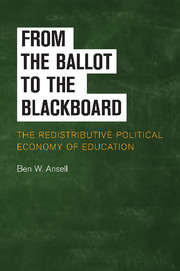Book contents
- Frontmatter
- Contents
- List of Tables
- List of Figures
- Preface
- 1 THE REDISTRIBUTIVE POLITICAL ECONOMY OF EDUCATION
- 2 THE EXPANSION OF EDUCATION TO THE MASSES: THEORY AND DATA
- 3 THE EXPANSION OF EDUCATION: HISTORICAL EVIDENCE
- 4 THE PARTISAN POLITICS OF EDUCATION
- 5 HIGH POLITICS IN HIGHER EDUCATION
- 6 CONCLUSION
- Bibliography
- Index
- Titles in the Series
1 - THE REDISTRIBUTIVE POLITICAL ECONOMY OF EDUCATION
Published online by Cambridge University Press: 06 July 2010
- Frontmatter
- Contents
- List of Tables
- List of Figures
- Preface
- 1 THE REDISTRIBUTIVE POLITICAL ECONOMY OF EDUCATION
- 2 THE EXPANSION OF EDUCATION TO THE MASSES: THEORY AND DATA
- 3 THE EXPANSION OF EDUCATION: HISTORICAL EVIDENCE
- 4 THE PARTISAN POLITICS OF EDUCATION
- 5 HIGH POLITICS IN HIGHER EDUCATION
- 6 CONCLUSION
- Bibliography
- Index
- Titles in the Series
Summary
TWO PUZZLES, TWO INSIGHTS
In 1951, the Indian government, buoyed by the fresh hopes of newly won independence, declared its intent that India should universally educate its population. It announced a program of massive government spending that would culminate in a sustained 6 percent of national income being devoted to public education spending. This ambition, codified in India's first Five Year Plan, was reiterated several times over the ensuing decades: by the Kothari Commission in 1966, and in the National Policy on Education in 1986 (Ghosh, 2000). Yet, even by 1995 India was spending barely half of this amount and remained home to one-third of the world's illiterates. The heady goals of the early independence movement were patently unmet in the field of human development. By the early 1990s, the debate around education in India was imbued with depression and recriminations. Why was India, a country famed for its unique level of democratic success in the developing world, unable to provide for the human development of its population?
This puzzle looks all the more confusing when we consider India's near-neighbor across the Andaman Sea: Malaysia. Governed under a semi-autocratic regime by leaders from the United Malays National Organisation (UMNO) party since 1969, Malaysia's executive is little constrained by the legislature, civil liberties are restricted, and opposition parties have been unable to secure government. While Malaysia is hardly a tyranny, it is significantly less open to political opposition and popular debate than is India.
- Type
- Chapter
- Information
- From the Ballot to the BlackboardThe Redistributive Political Economy of Education, pp. 1 - 19Publisher: Cambridge University PressPrint publication year: 2010

